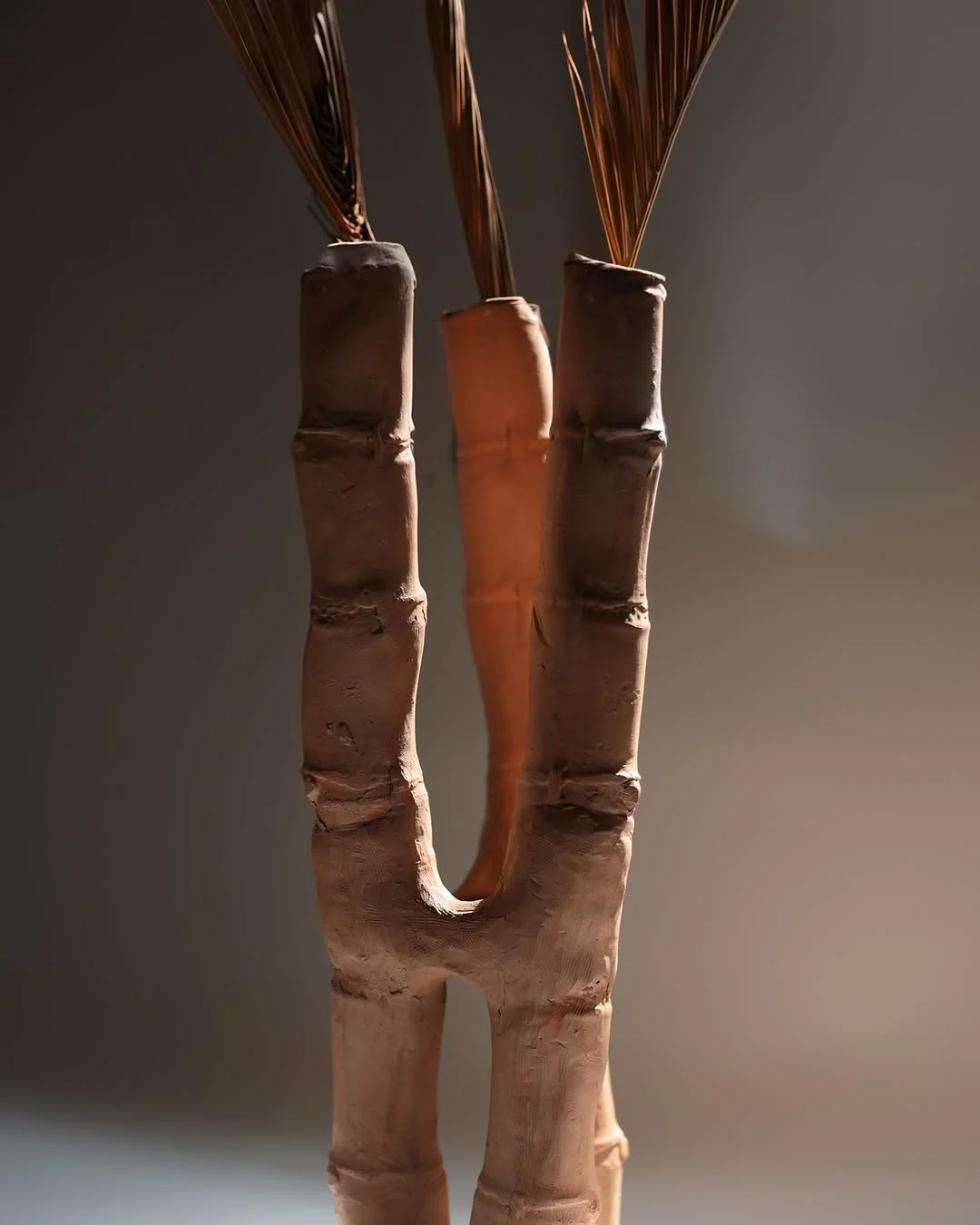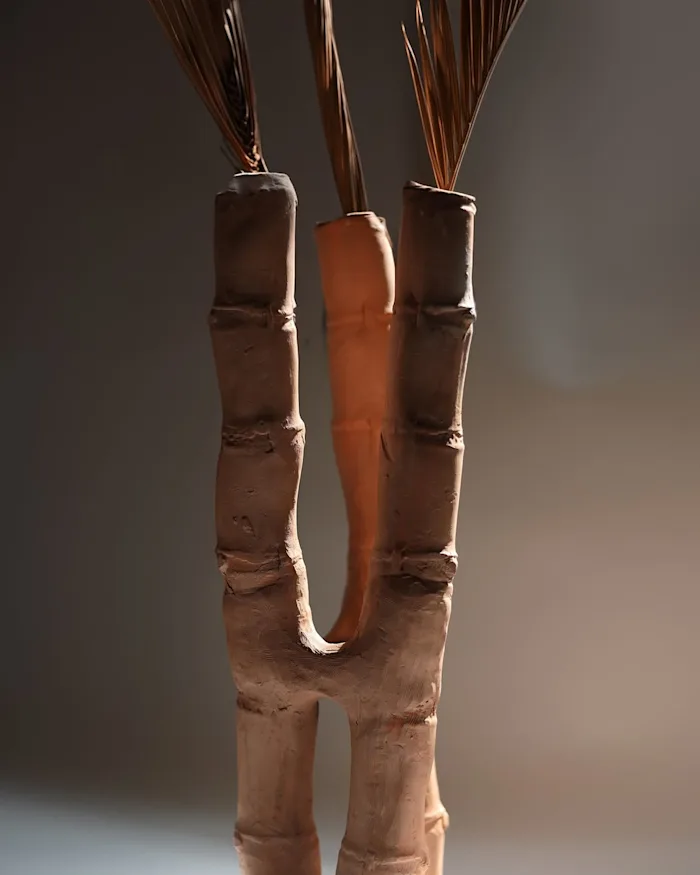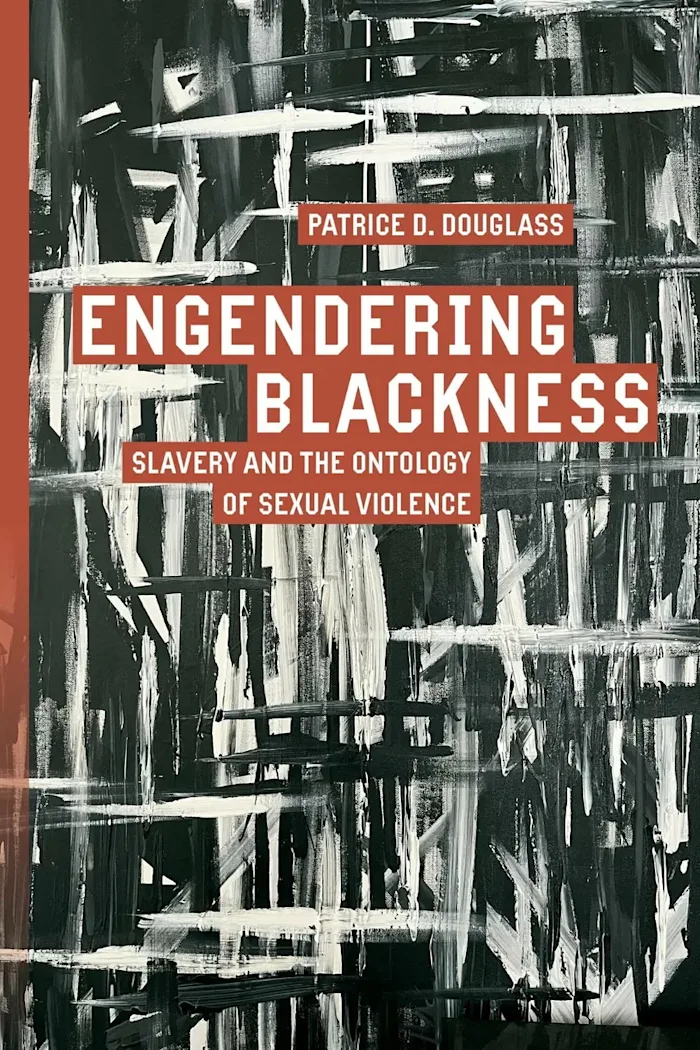Black Feminist Theoretical Dissemblance
Patrice Douglass
How does the Black female slave disfigure our received conceptions of gendered violence? It is this question that animates Patrice D. Douglass’ groundbreaking work, Engendering Blackness: Slavery and the Ontology of Sexual Violence, which appeared this week with Stanford University Press. While the effort in recent decades by Black feminists to recenter Black women's subjectivity offered an important corrective to colorblind feminism and masculinist conceptions of race, their intervention was not without its own blind spots. To designate female slaves as “Black women” amounted to a re-humanizing project, one which “stakes a claim on her gendered subjectivity as inalienable and innate.” In doing so, it is patriarchy (rather than Blackness) that becomes the defining quality through which the slave’s suffering became comprehensible. However, according to Douglass, if we wish to comprehend the physical and libidinal domination that subsumes the female slave, the category of “womanhood” cannot be treated as an uncritical given. In fact, the social identity of the Black woman is a “retroactive ascription placed upon the female slave post-emancipation,” and as such cannot illuminate the condition that preceded it. Such retroactive ascription constitutes a form of “theoretical dissemblance” that prolongs rather than subverts anti-Black violence. To reify Black womanhood above and apart from its concrete conditions “extends the very logics of violence this political gesture seeks to escape from,” by deputizing forms of speech and agency that presuppose a preliminary distance from enslaved bodies. If “what distinguishes woman from slave is precisely how each category is made intelligible or is obliterated by sexual violence,” then the question we ought to be asking concerns the very meaning of gender in a regime of pure violation?
In a 1994 article entitled “The Occult of True Black Womanhood,” Ann duCille wonders what will Black feminist studies look like in the face of the postmodern draw to oversaturate various milieus with Black women as a supreme form of otherness.1 She likens the overtheorization and marketing of Black women, in the academy and beyond, to what bell hooks termed “eating the other,” or “the commodification of otherness.”2 For duCille, her primary concern was to interrogate how Black women were being engaged and defined from outside of the field of Black feminist studies by people other than Black women.
duCille was responding to the 1980s and 1990s retreat from the racially distinct power movements of the 1960s and 1970s and the push to universalize subjects in theory. What resulted was a multiculturalist propensity to engage conditions of suffering as amalgams devoid of specificity for the purposes of performing theoretical sophistication and reach. Feminist theory, as well as other fields, were implicated in this maneuver. For duCille, such contemporary theoretical approaches were in tension with Third Wave feminisms, where theories by Black and other feminisms of color unapologetically centered race in feminist discourses on gender and sexuality, which was set in motion by 1970s women of color feminist activists.3 This particular move against the subsumption of race into generalized discussions about gender and sex is an ongoing attempt at carving out a distinct space for the discussion of racialized gender and sexuality and its attendant violences.
In the thirty-year span since the publication of “The Occult of True Black Womanhood,” Black feminist theory has enacted a response and position to duCille’s concerns. The field has taken up Black womanhood or the Black woman as its political signifier, such that, to speak of Black feminist issues signifies to the listener or reader that the primary subject of concern is the Black woman and the object of inquiry is the particularity of her suffering. This focus speaks back against eating the other, such that Black womanhood is not tangential to other disciplinary concerns, but a serious field or condition of inquiry situated on its own terms. In this respect, Black feminist theory contends with the status of the female slave in a manner that seeks to locate her elided or erased gendered Humanity both in and outside of the historical archive.
While Black feminist scholarship’s centering of Black women made crucial interventions in feminist and race theorizing, [I depart] from this work by exploring the plight and fantasy of the female slave while refusing the category of womanhood as constituent of this condition. Identifying the female slave as distinct from the category of woman, or from the imposition of Black womanhood, is not to suggest that woman is not a descriptor used in the historical archive to identify slaves. In fact, some gendered terms or descriptors used to describe female slaves included girl, female, wench, slave, and, at times, woman. However, the argument here parses out a conversation on gender and gendering by refusing to assume that the female slave is gendered ab initio as a woman based on assumptions that align with biological organs. The complications of this argument are that female and woman are both terms that exist within the biological assumptive framing of binary gendering. Such that the female is not natural or untainted by sociogenic principles embedded in beliefs about gender as locatable at the level of the physical body and in perceptions about inherent forms of difference.
Additionally, Black woman is not intended to be read equivalently with the category of woman. Black as a qualifier fundamentally changes the quality of woman. However, as will be discussed later, Black woman is a retroactive ascription placed upon the female slave post-emancipation. When applied to the slave, Black woman performs a labor of retelling and reimagining that demands its own interrogation. The female slave is not primarily Black in the archive, but is also African, negro, negress, or slave. While these terms overlap and bleed into one another, it is important to maintain their distinctions. Despite the Black being the slave of modernity, slave signifies on its own terms. By refusing the conflation of two undefinable affectable categories, the point is to consider how they are structured by converging and competing forces. It is also to ask, how does the female slave become the Black woman? Essentially the distinction between these two categories lies in a question of capacity.


In her groundbreaking book The Invention of Women: Making an African Sense of Western Gender Discourse, Oyèrónké Oyěwùmí argues that “the distinction between sex and gender is a red herring.”4 The argument that sex is biological and gender is socially constructed is an untenable argument when considering how biology is manufactured by the structures of power and fantasy that give gender meaning, matter, and form. Engaging biology as fixed, immutable, and/or universal disavows that biology is mutable, and thus shifts and reinforces its assumptions based on the social constructs and violence of race, as well as gender and ability. While social constructionist theory has prevailed in discussions around the convergent and divergent uses of sex and gender, it is critical to foreground violence, and particularly antiblack violence, in theorizing the modern preoccupation with these distinctions in feminist theory, as well as in general discourse. In this respect, the female slave as the conceptual framework that guides [us] is less insistent on considering femaleness in relationship to the physical body of the slave. However, this position is a priori embroiled with inescapable flaws insofar as every slave spoken of in this context is, based on genitals, sexed as female by the plantation system. Nonetheless, in the context of racial slavery, what female unearths is a designation of an object that is categorizable by its utility and quantifiable arrangements rather than as a psychosexual stage of potentiality toward womanhood as a form of ontological becoming. Rather, the female slave is permanently fixed as oppositional and distinct from woman as a subject constitution. The female slave is a stasis. Femaleness for the slave is rendered legible not on its own terms but through the forced affixing of the violent injuries attributed to womanhood, like rape, onto the slave as explanatory of its suffering. Woman is a violable subjectivity insofar as her ontological pursuit of self-possession seeks to dislodge her from being property for and of man. Her injury is located at the crux of self-possession and property status, where man forcibly dispossesses her consent, will, and agency by acting upon her subject based upon his possessive desire for power. Yet capacity for property status does not make her a slave, as property and slaveness are not inherently the same. Rather, property marks many relations and “proprietary claims and powers are made with respect to many persons who are clearly not slaves.”5
The interrogation of womanhood and femaleness that informs [my work] is preoccupied with Blackness and slaveness as they are dynamized by gender imposed under pure violation. The intent of this position is to wager how slavery, as an arrayed condition, is productive for unthinking the primacy of gender with respect to sexual violence and rape. The imposition of the slave into the sexual and the violent erodes preconceived perceptions of what constitutes the arrangements of history, but also has implications for how our engagements with history may impact the present. Furthermore, the argument here refuses to hold stridently to gender categories in an attempt not to reproduce biocentrism.
To be clear, the call is to not assume gender integrity, unless such can be proven to exist in the objects of analysis. Rather, it is to consider how, according to some gender theorists, gender can, even under oppressive conditions, be a space for freedom or self-making. Yet while non-slave bodies might be a target of gender and sexual violence, they are not inherently sites of containment for what one’s body can and should be and do for others. More, to be marked as non-slave is to be gendered as having a capacity and relation to slaves. The description of slaves as gendered subjects does not determine that the discourse and narrative of gender is explanatory of their conditions. As Sylvia Wynter has argued,
If the Black–White Distinction functioned to fix the Major Referent and optative identity for all groups and races, the gender-distinction, man/woman functioned to replicate the representation of “natural Difference” which bonds the order, enabling it to function as a sociodicy, i.e., an order whose empirical everyday praxis justifies the ways of the order to itself. Both the Black-White and the Gender distinction as well as the related “naturalness” of heterosexuality to the “unnaturalness of all forms of nonheterosexuality, served to substantialize the order’s discourse of justification.”6
Gendered categories are both reinscribed as natural and as the logical terms to make sense of their violent arrangements. Which is to say, gendered categories are upheld as the predicating reason for injury, the why, and the explanatory reason for the violence, the because. However, relying on gender, its terminology and conceptual frameworks as the order of all things, as a form of primacy for thought, reifies it as the essential sociodicy of violence. While this may be the case for the Human, the Black slave disfigures the gender canon with respect to violence. Simply stated, one cannot definitively assert that gender functions as the why and because of the sexual perversity of slavery (though it may texture the analysis), it does not impart reason. The sexual(ized) violations of slavery, as a structure of violence rather than an experience, betrays rather than reifies the sociodicy of feminist frameworks. The assumptive logic of the feminist project is that gender degrades the subject upon and after arrival. The Black feminist tradition presented here asks how natal alienation, general dishonor, and gratuitous violence dispossess the slave of being, structurally occluding the possibility of the arrival of a subject. As such, there is no slave gendered subject, insofar as the slave is a violent projection and captive possession of Human gender ontology.


Over the past two decades, the literature written on race, gender, and slavery centers Black women as the predominating lens of analysis. With the exception of a limited number of recently published works, the female slave as a category has largely been abandoned by Black feminist elaborations in favor of the use of enslaved Black woman or simply enslaved woman.7 Although even in cases where the female slave is concretely theorized, the term is also deployed interchangeably with enslaved woman. The unspoken or silent contention present in the privileging of the Black and/or enslaved woman over female slave involves perceptions about dehumanization, where designating female slaves as Black women is an attempt at a humanizing or re-humanizing gesture that stakes a claim on her gendered subjectivity as inalienable and innate. Framing slavery as such contends that violation for the slave harkens on denied Humanity that is reclaimed through a possessive investment in gendering through naming. However, this guarding of “woman” as the slave’s gendered Human right is rooted in a biocentric association wherein genitals are taken as the content of proof upon which the politic is staged. Which is to say, gender in this respect is a claim on the perceived biological instantiation of what it means to be a woman that is then particularized through the racialization of the slave, which is maintained at the level of bodily experience. The historiography of Black womanhood is propped up by reading slave gendering as a marked bodily constitution that is degraded in a hegemonic struggle for power and recognition with the master, mistress, and male slave. What lies beneath this assumptive logic is that in order to grant the female slave credence as a speaking and acting subject, her suffering must be mimetically ciphered through the representational schemas of the contractual schisms of cis-centrism, such that patriarchy, rather than her Blackness, becomes the essential quality of her (un) gendered or unnamed suffering. Additionally, theories of slavery and gender that speak against cis-binarism are not immune to having to contend with a structure that forcefully upholds gender as a fact of the body while denying how gendering is made real through racial social sexual relations that are oriented by antiblackness.
Marking Black womanhood as the essence of the female slave that must always be returned to is emblematic of what I call a theoretical politics of dissemblance, which is a term drawn in part from the work of Darlene Clarke Hine. “By dissemblance,” Hine argues, “I mean the behavior and attitudes of Black women that created the appearance of openness and disclosure but actually shielded the truth of their inner lives and selves from their oppressors.”8 Hine is interested in how certain puritanical ways of being are performed by Black women to counteract narratives of their inherent sexual perversity that were used as justification for their sexual violation in antebellum and postbellum life. Additionally, Hine charts how a “cult of secrecy” around sexuality was also a tactic employed by Black women to help secure jobs in the unskilled and semiskilled labor markets to move their labor out of domestic spaces where they were subjected to wanton sexual violations in the intimate spaces of white homes. Hine theorizes dissemblance as a complicated arrangement of racial, class, and gender responses and associations that are enacted by Black women to ascend racial, sexual, and social statuses and ascriptions. In a sense, dissemblance can be understood as a practice through which Black women attempted to contest their social conditions to enter new and, seemingly, more safe spaces. However, what emerged in the context of secrecy around sex are various new forms of exclusion where Black women created women’s clubs and social societies to support their new senses of self and social stature.


Evelynn M. Hammonds interrogates dissemblance and secrecy as not only means to an end for self-protection but also ways Black women themselves created exclusionary practices that, through silence, center Christian heteronormativity as the predominant form of Black sexual presence. For Hammonds, these practices in essence leave Black women’s sexuality underdefined. Additionally, as Hine and Hammonds make clear, these practices leave the contexts of sexual violation and violence that Black women are up against veiled behind a politics that cannot tell nor confront the contours of the very thing it is resisting. Additionally, these silences, as Hammond critically argues, demonstrate how black women’s sexuality is a belated and reductive consideration where the complexities and potentials are crowded out by the automatic assumption of compulsory heterosexuality.
Dissemblance is theoretically rooted and socially performative. The former emerges most clearly in theoretical spaces centrally concerned with the pain constitution of the Black woman. Hammonds argues that in Black feminist theory, the theorists themselves inure a relation to Black women and their sexuality that imparts an extension of dissemblance and silence. She contends that “the goal should be to develop a ‘politics of articulation’ that would build on the interrogation of what makes it possible for Black women to speak and act.” Black feminist theory is sutured by a double bind where its approach to exposure can symptomatically reveal its entrapment to a theoretical politics of dissemblance. This dualism appears through a performed refusal to contend with the obscene, as a way to protect Black women, or the category of Black woman, from being overdetermined by pejorative and perverse ascriptions of her sexual beingness. To say this otherwise, the impetus to hold Black womanhood as separate or distinct from its inhabited conditions reinforces understandings of gender and sexual difference that extend the very logics of violence this political gesture seeks to escape from. Imbued within the structural predicaments of womanhood, despite its Blackening by terminological associations, is that the cult of silence is parasitic upon slave sexual openness to announce its distinction and ontological right within the Western epistome. However, in order for woman to be distinct from man it must also be distinct from slave, which makes up the triumvirate of modern racial gender violence. What distinguishes woman from slave is precisely how each category is made intelligible or is obliterated by sexual violence.
The entrapment of Black feminism within the triumvirate of woman–man–slave is that its theoretical politics of dissemblance reveals that its move toward a claim on womanhood does not resolve the slave — because it cannot disintegrate its historical presence. Rather, the qualities of womanhood that are upheld in theory partake in a theoretical politics of dissemblance by refusing to ask, with respect to the above provocation by Hammonds, “what makes it possible for the Black woman to speak and act” that is impossible for the female slave? Some might argue that the distinction between the categories is simply semantic and that across time, female has become supplanted with woman/women as a casual progression emblematic of a shift in political language. However, what has also occurred with this shift is a deputization of womanhood to the ends of forms of speech and action that challenge the absence of these qualities in the historical record for the female slave. Which is to say, the female slave as a fixed recipient of violation is countered by presenting the Black woman of history as a speaking and acting willful agent. Again, the question remains, what makes the agentic Black woman possible?
With respect to the woman–man–slave relation, theoretical dissemblance is eerily silent about gender intelligibility as a form of violent subjectivity. Gender is not a given but is a form of structural making and integrity between the dualism of woman–man, which is clarified through how each of these categories violently relates to the slave. Lastly, if womanhood is taken up as a category, politic, or term against femaleness as a state of pure violation or nascent form, then what makes the woman cohere demands interrogation.9
Patrice D. Douglass’ Engendering Blackness: Slavery and the Ontology of Sexual Violence, is available now from Stanford University Press.


Images: Patricia Encarnación
Notes
1. Ann duCille, “The Occult of True Black Womanhood: Critical Demeanor and Black Feminist Studies,” Signs 19, no. 3 (Spring 1994).↰
2. bell hooks, Black Looks: Race and Representation, South End Press, 1992, 12.↰
3. See The Combahee River Collective, “A Black Feminist Statement,” in The Second Wave: A Reader in Feminist Theory, ed. Linda Nicholson, Routledge, 1997; Cherríe L. Moraga and Gloria E. Anzaldúa, eds., This Bridge Called My Back: Writings by Radical Women of Color, Kitchen Table, Women of Color Press, 1983; Gloria Anzaldúa, Borderlands: La Frontera, Aunt Lute Books, 1999.↰
4. Oyèrónkẹ́ Oyěwùmí, The Invention of Women: Making an African Sense of Western Gender Discourses, University of Minnesota Press, 1997, 9.↰
5. Orlando Patterson, Slavery and Social Death: A Comparative Study, Harvard University Press, 1982, 21.↰
6. Sylvia Wynter, “Beyond Liberal and Marxist Leninist Feminisms: Towards an Autonomous Frame of Reference,” CLR James Journal 24, no. 1–2 (Fall 2018).↰
7. See Marisa J. Fuentes, Dispossessed Lives: Enslaved Women, Violence, and the Archive, University of Pennsylvania Press, 2016; Habiba Ibrahim, Black Age: Oceanic Lifespans and the Time of Black Life, New York University Press, 2021; Jessica Marie Johnson, Wicked Flesh: Black Women, Intimacy and Freedom in the Atlantic World, University of Pennsylvania Press, 2020; C. Riley Snorton, Black on Both Sides: A Racial History of Trans Identity, University of Minnesota Press, 2017.↰
8. Darlene Clark Hine, “Rape and the Inner Lives of Black Women in the Middle West,” Signs 14, no. 4 (Summer 1989), 912.↰
9. The passage presented here has been excerpted from Engendering Blackness: Slavery and the Ontology of Sexual Violence by Patrice D. Douglass, published by Stanford University Press, ©2025 by Patrice D. Douglass. All Rights Reserved.↰